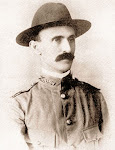 Here's an amazing little piece of trivia... the Philippine-American War is the only international war that was started by a Nebraskan. Pvt. William "Willie" Grayson (1876-1941) was an English immigrant from Beatrice, Nebraska who fired the shot that ignited the Philippine-American War, a conflict that would last for over three and a half years and claim over 4,100 American lives.
Here's an amazing little piece of trivia... the Philippine-American War is the only international war that was started by a Nebraskan. Pvt. William "Willie" Grayson (1876-1941) was an English immigrant from Beatrice, Nebraska who fired the shot that ignited the Philippine-American War, a conflict that would last for over three and a half years and claim over 4,100 American lives.Pvt. Grayson was a member of Company D of the 1st Nebraska Volunteer Infantry Regiment. Grayson and the 1st Nebraskans had been experiencing extreme tensions with the Filipinos for over a month. The Filipinos seemed anxious to provoke the Americans into a hostile act, and strict orders were issued to prevent any action. Night after night they would cluster around and shout curses at the American outposts. One insurgent officer was particularly abusive. He would gather a crowd of drunken natives, and they would march down to the bridge for the purpose of harassing and scoffing at the American soldiers. They were encouraged by the apparently submissive attitude of the Americans, whom they had begun to look upon as cowards.
The incident that touched off the conflict occurred on the evening of Saturday, February 4, 1899. Grayson said: “About eight o’clock, Orville Miller and I were cautiously pacing our district. We came to a fence and were trying to see what the Filipinos were up to. Suddenly, near at hand, on our left, there was a low but unmistakable Filipino outpost signal whistle. It was immediately answered by a similar whistle about twenty-five yards to the right. Then a red lantern flashed a signal from blockhouse number 7. We had never seen such a sign used before. In a moment, something rose up slowly in front of us. It was a Filipino. I yelled ‘Halt!’ and made it pretty loud, for I was accustomed to challenging the officer of the guard in approved military style. I challenged him with another loud ‘Halt!’ Then he shouted ‘Halto!’ to me. Well, I thought the best thing to do was to shoot him. He dropped. If I didn’t kill him, I guess he died of fright.
Two Filipinos sprang out of the gateway about 25 yards from us. I called ‘Halt!’ and Miller fired and dropped one. I saw that another was left. Well, I think I got my second Filipino that time....” As they ran back to their post, Grayson shouted, “Line up fellows, the niggers are in here all through these yards.”
Filipino troops at San Juan del Monte exchanged fire with the American line at Sta. Mesa. The companies of the Morong Battalion under Captain Narvaez and Captain Vicente Ramos charged the American positions and pushed back the 1st Nebraskans and even captured an American artillery piece. By 10 o’clock at night the American troops were engaged for two miles from Pasig River north and west.”
Upon his return to the United States from the Philippines, Grayson settled in San Francisco, California and got married in October 1899. He acquired U.S. citizenship in 1900. He later worked as a house painter and an undertaker.






